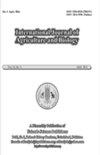Heritability for Morphological Traits Determine Adaptability of Elite Cowpea Genotypes in different Environments
Q2 Agricultural and Biological Sciences
引用次数: 1
Abstract
Lack of improved and high-yielding adapted varieties constitutes limitation to cowpea (Vigna unguiculata (L.) Walp) production in South Africa. Therefore, field trials were conducted in two locations (the University of Limpopo Experimental Farm, (Mankweng) and Towoomba Research Station, Bela-Bela) during 2015–16 and 2016–17, to assess yield components, genotype x environment interaction as well as the adaptability of elite cowpea genotypes. The experiment was laid out using a randomized complete block design in three replications. Data were collected on flowering, maturity and yield components. Results revealed that “genotype, and genotype × year and genotype × location interactions were significant for most of the traits evaluated”. „The days to 50% flowering‟ and „90% maturity‟ ranged between 53 and 60 days, and between 89 and 96 days, respectively. The „100-seed weight‟ varied from 15.8 g to 22.5 g. „Broad-sense heritability‟ varied from 0 to 93% for days to maturity and grain yield, respectively. „Grain yield‟ varied from 1465.7 to 2594.9 kg ha-1, and the best yielders were lines „L2‟, „L10‟, and „L7‟. The „PC1‟ and „PC2‟ explained 82.57% variation for maturity, 79.12% for the „pods per plant‟, 83.78% for „seeds per pod‟, 93.09% for „100-seed weight‟ and 95.84% for „grain yield‟. Towoomba was a more productive location compared to Sykerfuil. Lines „L2‟, „L10‟, and „L7‟ yielded very well in both locations and years. This implies that they are adapted and are recommended for registration and commercial release in the region. © 2021 Friends Science Publishers形态性状的遗传力决定了优良豇豆基因型对不同环境的适应性
缺乏改良和高产的适应品种是豇豆(Vigna unguiculata (L.))的限制。南非的Walp生产。因此,我们于2015-16和2016-17年在两个地点(林波波大学实验农场(mankeng)和Bela-Bela的Towoomba研究站)进行了田间试验,以评估优良豇豆基因型的产量组成、基因型与环境的相互作用以及适应性。试验采用随机完全区组设计,分3个重复。收集了花期、成熟期和产量组成部分的数据。结果表明,“基因型、基因型×年和基因型×位置的互作对大多数性状具有显著影响”。“50%开花”和“90%成熟”的天数分别为53 ~ 60天和89 ~ 96天。“百粒重”从15.8 g到22.5 g不等,“广义遗传力”从0到93%不等。籽粒产量在1465.7 ~ 2594.9 kg hm -1之间变化,产量最好的品系是“L2”、“L10”和“L7”。“PC1”和“PC2”解释了成熟度82.57%、“单株荚果”79.12%、“每荚种子”83.78%、“百粒重”93.09%和“籽粒产量”95.84%的变异。与Sykerfuil相比,Towoomba是一个生产力更高的地方。线条“L2”,“L10”和“L7”在两个位置和年份都很好。这意味着它们经过改编,并建议在该地区进行注册和商业发行。©2021朋友科学出版社
本文章由计算机程序翻译,如有差异,请以英文原文为准。
求助全文
约1分钟内获得全文
求助全文
来源期刊

International Journal of Agriculture and Biology
AGRICULTURE, MULTIDISCIPLINARY-
CiteScore
1.70
自引率
0.00%
发文量
40
审稿时长
5 months
期刊介绍:
Information not localized
 求助内容:
求助内容: 应助结果提醒方式:
应助结果提醒方式:


